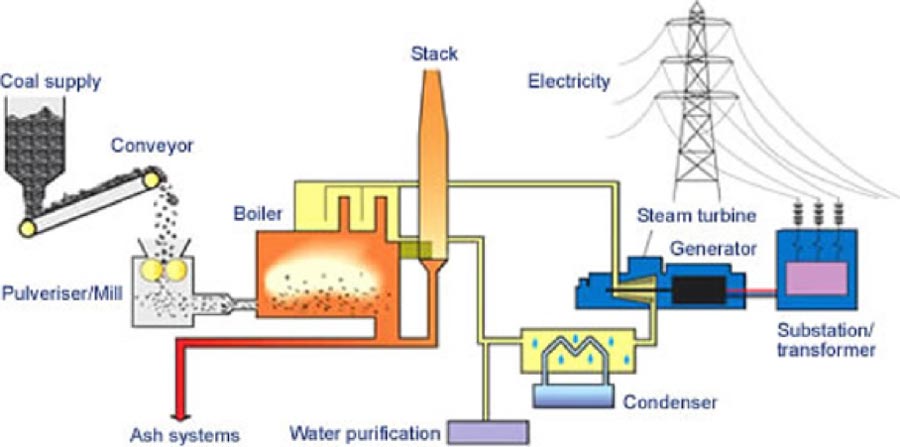COAL POWER PLANTS & ELECTRICITY
Modern life is unimaginable without electricity. It lights houses, buildings, streets, provides domestic and industrial heat, and powers most equipment used in homes, offices and machinery in factories. Improving access to electricity worldwide is critical to alleviating poverty.
Coal plays a vital role in electricity generation worldwide. Coal-fired power plants currently fuel 41% of global electricity. In some countries, coal fuels a higher percentage of electricity.
| Coal in Electricity Generation |
|---|
| South Africa 93% | Poland 87% | PR China 79% |
| Australia 78% | Kazakhstan 75% | India 68% |
| Israel 58% | Czech Rep 51% | Morocco 51% |
| Greece 54% | USA 45% | Germany 41% |
| Indonesia | 376Mt | Kazakhstan |
How is Coal Converted to Electricity?
Steam coal, also known as thermal coal, is used in power stations to generate electricity.
Coal is first milled to a fine powder, which increases the surface area and allows it to burn more quickly. In these pulverised coal combustion (PCC) systems, the powdered coal is blown into the combustion chamber of a boiler where it is burnt at high temperature (see diagram below). The hot gases and heat energy produced converts water – in tubes lining the boiler – into steam.

The high pressure steam is passed into a turbine containing thousands of propeller-like blades. The steam pushes these blades causing the turbine shaft to rotate at high speed. A generator is mounted at one end of the turbine shaft and consists of carefully wound wire coils. Electricity is generated when these are rapidly rotated in a strong magnetic field. After passing through the turbine, the steam is condensed and returned to the boiler to be heated once again.
The electricity generated is transformed into the higher voltages (up to 400,000 volts) used for economic, efficient transmission via power line grids. When it nears the point of consumption, such as our homes, the electricity is transformed down to the safer 100-250 voltage systems used in the domestic market.
HOW DO COAL-FIRED PLANTS WORK?
Coal, oil, gas and nuclear fuels can be used to heat water and convert it into steam at high temperatures and pressures. This is done in boilers or reactors. The very hot steam, at temperatures of between 500 C and 535 C, is released and turns a large turbine, connected to the rotating magnet and electricity is generated. In this way the energy in the fuel has been converted into electricity.
In a coal-fired steam station water is turned into steam, which in turn drives turbine generators to produce electricity. Here’s how the process works.
1. Heat is created
Before the coal is burned, it is pulverized to the fineness of talcum powder. It is then mixed with hot air and blown into the firebox of the boiler. Burning in suspension, the coal/air mixture provides the most complete combustion and maximum heat possible.
2. Water turns to steam
Highly purified water, pumped through pipes inside the boiler, is turned into steam by the heat. The steam reaches temperatures of up to 1,000 degrees Fahrenheit (537.778 degrees) and pressures up to 3,500 pounds (1,587 kilograms) per square inch, and is piped to the turbine.
3. Steam turns the turbine
The enormous pressure of the steam pushing against a series of giant turbine blades turns the turbine shaft. The turbine shaft is connected to the shaft of the generator, where magnets spin within wire coils to produce electricity.
4. Steam turns back into water
After doing its work in the turbine, the steam is drawn into a condenser, a large chamber in the basement of the power plant. In this important step, millions of gallons of cool water from a nearby source (such as a river or lake) are pumped through a network of tubes running through the condenser. The cool water in the tubes converts the steam back into water that can be used over and over again in the plant.
The cooling water is returned to its source without any contamination, and the steam water is returned to the boiler to repeat the cycle.
